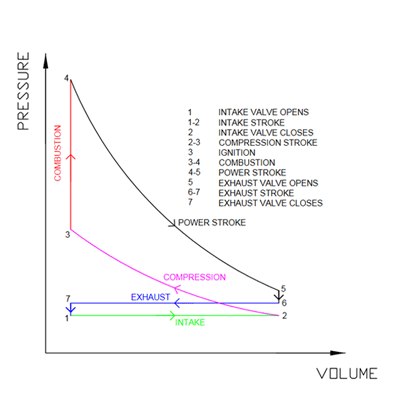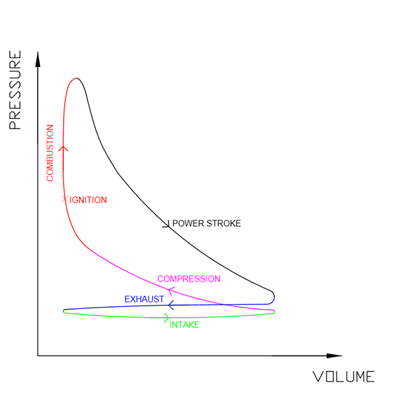P-V Cycle
The Internal Combustion Engine Pressure-Volume Cycle
The P-V cycle is the pressure vs. volume relationship that exists in the cylinder throughout the induction,
combustion, expansion, and expulsion processes. This cycle is fundamental to engine design and optimization.
Let’s start by looking at a typical P-V chart to understand what is going on here. This is an idealized case,
as the actual chart does not have sharp corners, but more rounded transitions from one part of the cycle to
the next. However, this is more convenient and allows cycle analysis without computer modeling and thousands
of points of data. Seeing how this is simply an explanation of what is occurring inside the engine, it will be fine.

In an actual engine, valves do not open at a finite time, they begin to open before top dead center (TDC) or
bottom dead center (BDC) and stay open past the respective point. This is actually a critical variable to engine
performance, and can radically shape the operating characteristics of an engine. More discussion on cam specifications
to follow in the Camshaft and Valve Train article.
As you can see from the chart, the pressure vs. volume curve is not a straight line, that is the most significant
compression occurs near the top of the piston stroke, and the most significant amount of pressure is converted to
useful work also when the piston has just passed the top of its stroke. During the inlet and exhaust phases, we do
not see this phenomenon due to the valves being open and the pressure being essentially intake or exhaust manifold
pressure. Please see the P-V calculators in that section to see how different compression ratios affect the pressures
in the cylinder and the overall cycle.
Figure 2 is a more realistic P-V diagram, and shows the smooth change in pressures that accompany the moving piston.
Also note that ignition occurs prior to top dead center, and that pressure actually continues to increase even after
the piston has begun to go back down as the intake fuel/air mixture completely burns. This gives you some idea why
the engine actually fires before top dead center, which is simply a way to extract the most useful energy from the
fuel/air mixture and give the mixture time to burn completely. For more on timing, please refer to Ignition Timing.
